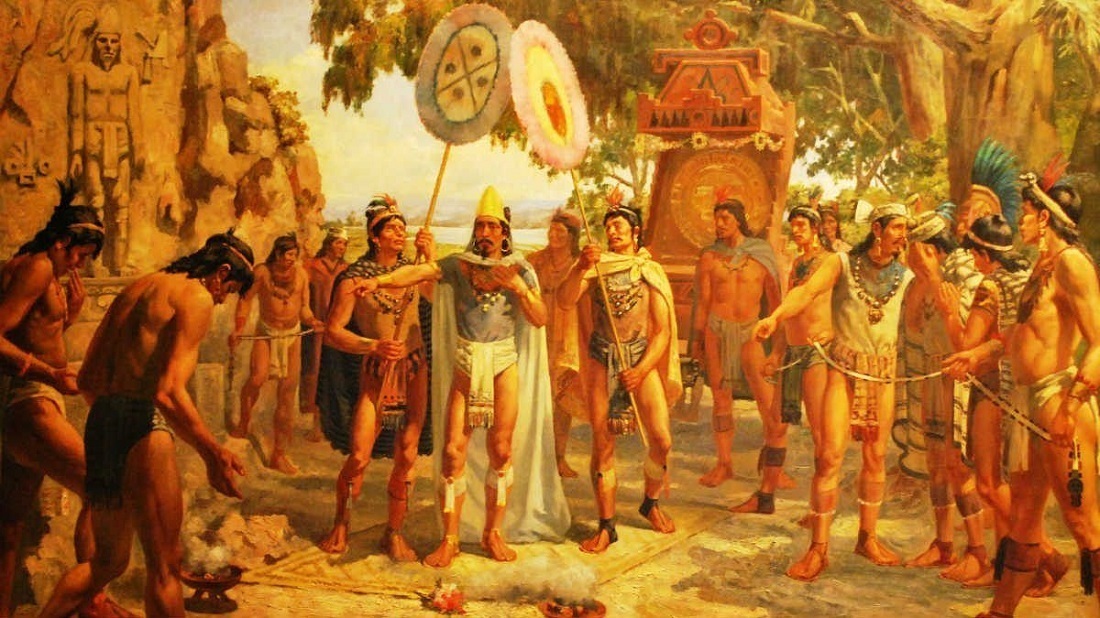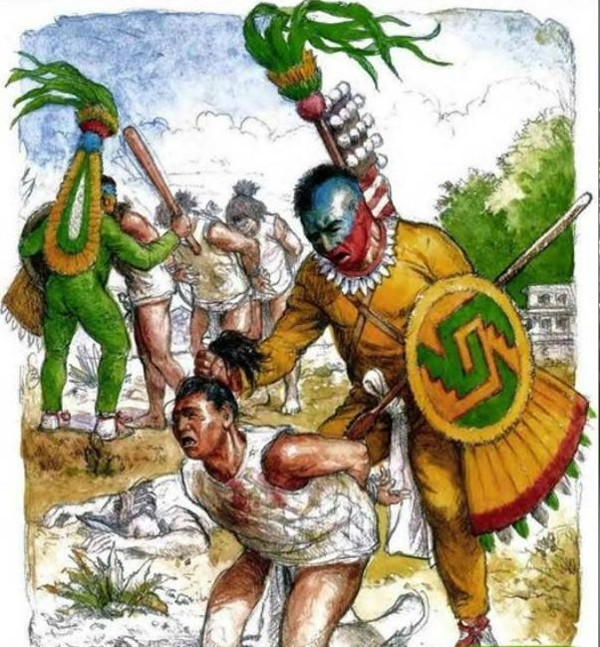Find out in this interesting article how the Political Organization Of The Aztecs, its characteristics, important aspects and much more. Do not stop reading it!, there we will inform ourselves about how this society was politically structured.

Political organization of the Aztecs: figures of power
The political organization of the Aztecs refers to how the ancient Mexican civilization distributed and ordered its figures of power. In general, the organization of this Empire was based on a collective administration where blood ties and family structures were important.
In other words, the Mexican territories were divided among very prestigious families. Likewise, the main character was the Tlatoani; a kind of emperor chosen by a council made up of nobles and representatives of important families.
Although the tlatoanis were chosen by a council, these rulers still had to have a blood affinity with the king who preceded them. Therefore, the nobles chose the next tlatoani from the group of sons of the previous tlatoani.
The Aztec state was formed by the Triple Alliance, which consisted of the union of three important cities: Texcoco, Tlacopan and Tenochtitlan. However, the greatest power was consolidated in Tenochtitlán; that is to say that from this town the others were controlled and watched.
It should be noted that a large part of the territories of the Aztec Empire consisted of conquered peoples. These cities kept their rulers and their way of life, but they had to pay homage to the main city.
These taxes generated discontent in the dominated cities, which in revenge repeatedly helped the Spanish to end the rule of Tenochtitlan.
Political organization of the Aztecs: figures of power
The Huey Tlatoani: he was the most important celebrity in the organization of the Aztecs. He was considered an emissary of the gods, that is, a direct representative of the deities. The words huey tlatoani can be translated as "great speaker".
The Huey Tlatoani were chosen by the pīpiltin, a group of nobles who formed the Aztec council. Some authors affirm that the Aztec state functioned as a kind of hereditary monarchy, since only the children of the tlatoani could access this position.
The Cihuacoatl: Within the political structure, the Cihuacóatl occupied the second position within the power structure. They were the chief priests and their role was similar to that of a prime minister.
In general, the Cihuacóatl was responsible for replacing the tlatoani in case of absence; He was also the supreme judge within the judicial and military elements.
In addition, the Cihuacóatl could organize military expeditions and call an electoral meeting in case the tlatoani died.
The council or Tlatocan: it was the Aztec committee and was made up of a group of 14 men belonging to the nobility, who held one of the following positions:
-Religious leaders.
– Administrators.
– Military leaders.
– Heads of population or important families.
– War advisers.
At council meetings, the Cihuacóatl proposed a topic for discussion and the other members offered their views. Once completed, Huey Tlatoani made the final decision based on the options presented to him by his advisors. For this reason, historians agree that the members of the tlatocan were very influential people in Aztec society.
The Tlacochcalcatl: translates as "the man from the house of darts" and was used to refer to Mexican generals. In military decisions, the Tlacochcalcatl ranked second after the Tlatoanis. These generals had the duty to lead armies and plan war campaigns. In addition, the Tlacochcalcatl also had to protect the arsenals of the troops, which were kept in the Tlacochcalco (the house of darts).
The Tlacateccatl: He was a military figure who followed the important Tlacochcalcatl. The duty of these soldiers was to protect the barracks located in the center of Tenochtitlán. The Tlacateccatl generally assisted the Tlacochcalcatl in decision making and in the control of troops.
The Huitzncahuatlailotlac and the Tizociahuacatl: these positions were used to appoint the chief judges within the Aztec Empire. The objective of these nobles was to do justice to Mexican society; likewise, the positions were generally held by wealthy and educated people.
The Tlatoani or head of province: they were the governors of the Aztec regions. They had a duty to maintain order within their territories.
Although they had some autonomy, they had to meet with the huey tlatoani from time to time to report on the growth of the province and deliver accounts on the collection of tributes.
The Tecuhtli: The word translates as "lord" and has been used to refer to overseers of tributes. In other words, the tecuhtli were administrators responsible for collecting taxes.
Administration of power from taxes or tributes
To maintain order and authority in the conquered territories, all the Aztec provinces had to pay a series of tributes so that they were administered to Tenochtitlán.
In general, the taxes were specific goods (food, textiles, among others) sent by the governors on regular schedules (ie, from time to time per year).
Likewise, the provinces that issued these taxes were once communities with other languages and beliefs subject to the authorities of Tenochtitlán.
These communities agreed to make this payment because they had no Aztec military power. In fact, if they did not pay the taxes, the Mexica could threaten these communities with a war attack.
Administration of the provinces
According to Spanish chronicles, the Aztec Empire was divided into 38 provinces. These territories, after being conquered by the Aztecs, kept their local chiefs and had a certain independence to carry out their traditions and customs.
Thanks to the tributes from these provinces, the Triple Alliance was able to spread rapidly and become a vast empire. This happened because the taxes were used to finance not only military campaigns, but also the development of infrastructure and agriculture.
Your model and system
Accompanied by a skillful military strategy, the political organization of the Aztecs was based on a scheme intended to ensure power in all the conquered territories in Mesoamerica.
In this way, with different officials who controlled the counties under a fiscal regime in kind, they managed to make many towns submit to the empire.
The Triple Alliance in the political organization of the Aztecs
By establishing a platform called the Triple Alliance, the political organization of the Aztecs revolved around the confederation of three city-states, namely Tenochtitlán, Texcoco and Tlacopan.
This Commonwealth fought several battles of conquest that allowed it to develop rapidly, however, the city of Tenochtitlán has always been the dominant partner.
Although this imposed power can be seen as indirect, because most of the rulers of the conquered territories remained in their positions, the tributes granted by the Triple Alliance cost the Mexica the resentment of the submissive peoples.
So much so that many of them helped the conquerors to defeat the empire. On the other hand, the governmental administration of the Aztec culture was based on the power of the nobility that was under the command of an emperor.
How the political organization of the Aztecs was hierarchical
For the purposes of the previous references, the political organization of the Aztecs based on the power of the nobility, had the following hierarchy:
- The emperor or Huey Tlatoani, who had a divine mandate, concentrated all the political, religious, military, commercial and social faculties of the empire, in addition, he appointed the rulers of the cities and promoted the growth of the territory based on wars. of conquests, to obtain the greatest amount of tributes.
- The Supreme Council or Tlatocán, which supported Huey Tlatoani in government decisions, was made up of members of the Aztec bureaucracy.
- Cihuacóatl or head of the priests, was the trusted person of the emperor, who relieved him of his duties during his absence.
- Tlacochcálcatl and Tlacatécatl were in charge of organizing the army, establishing war tactics and leading them, being responsible for the victories and defeats.
- Huitzncahuatlailotlac and Tizociahuácatl were the main judges of the Aztec government.
- Tlatoani or sovereign, belonging to the nobility, governed the cities of the empire.
- Tecuhtli, or tax attorneys, were responsible for the correct payment of taxes in the conquered regions.
- Calpullec, was formed by the different leaders of the Calpullis.
It can be concluded that the political organization of the Aztecs reveals that one of the virtues of this great civilization was precisely its great military power and its level of political-territorial organization, which resulted in great wealth.
If you found this article interesting, we invite you to enjoy these others:




